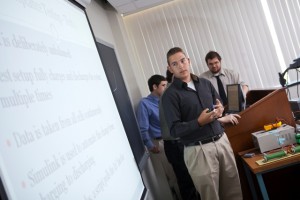
Erik Adolfsson ’11 and fellow electrical and computer engineering students present the results of their senior design project.
For Erik Adolfsson ’11, his senior design project taught him a large range of skills that will help him as moves on to his first position as a technical sales associate for Texas Instruments in Dallas, Texas.
“I have learned about scheduling tasks, delegating work, and how difficult it is to design a system from the ground up,” he says. “This project has definitely given me a better understanding of how projects are developed and some of the unique challenges of working with a team of engineers.”
This past school year, Adolfsson and five of his fellow graduating seniors continued the electrical & computer engineering (ECE) department’s ongoing work in sustainable energy technology. The design course focused on state-of-the-art battery technology, which is “a key aspect of today’s ‘green technology,’ such as wind and solar power generation, ‘smart grid’ power distribution, and electric vehicles,” explains Chris Nadovich, ECE lab director, who served as one of the project’s faculty advisers.
The students added an independent cell management capability to the Lafayette Photovoltaic Research and Development System (LPRDS). LPRDS involves transferring energy from a solar panel array on the roof of Acopian Engineering Center for various building and campus uses through a supervisory control and data acquisition system. The new feature coordinates the charging and discharging of an array of Lithium Iron Phosphate (LiFePO4) cells on an individual cell-by-cell basis. Control of individual cells maximizes battery capacity as it increases service life. The end result is a cheaper, better battery for energy storage and management.
“Basically, all batteries are different and they charge at different rates. Some are fast, some are slow,” says Adolfsson. “We built a circuit to balance four cells so they are all full of charge instead of some overcharging and some not charging enough.”
According to Nadovich, the work involved a wide variety of multidisciplinary engineering design tasks. “System level requirements were not the only electrical design constraints, but mechanical, chemical, and thermal considerations as well. The students conducted a wide range of analysis and design tasks, including multi-physics modeling, reliability and manufacturability studies, and regulatory determinations.”
There was also significant collaboration with the chemical engineering department. Robert Lovelett ’11, who graduated with a B.S. in chemical engineering in May, and his thesis adviser Javad Tavakoli, professor of chemical engineering, worked in parallel to this project on the detailed chemical aspects of multi-physics LiFePO4 cell modeling and analysis.
“I looked at modeling of battery state of charge and eventually state of health,” says Lovelett. “For validation of my model, I worked with the ECE team to gather charge/discharge data on lithium iron-phosphate cells. I hope that my results were useful to the team to better estimate battery state of charge.”
Lovelett, who has always been interested in different aspects of energy research, will be pursuing a Ph.D. at the University of Delaware. He plans to focus on energy research or a related field, such as fuel cells or biofuels.
The ECE senior design team was also comprised of Justin Bunnell ’11, Gregory Earle ’11, Samuel Friedman ’11, Ricardo Quan ’11, and William Kiewicz-Schlansker ’11. John Greco, professor of electrical & computer engineering, also served as a faculty adviser.

2 Comments
Comments are closed.